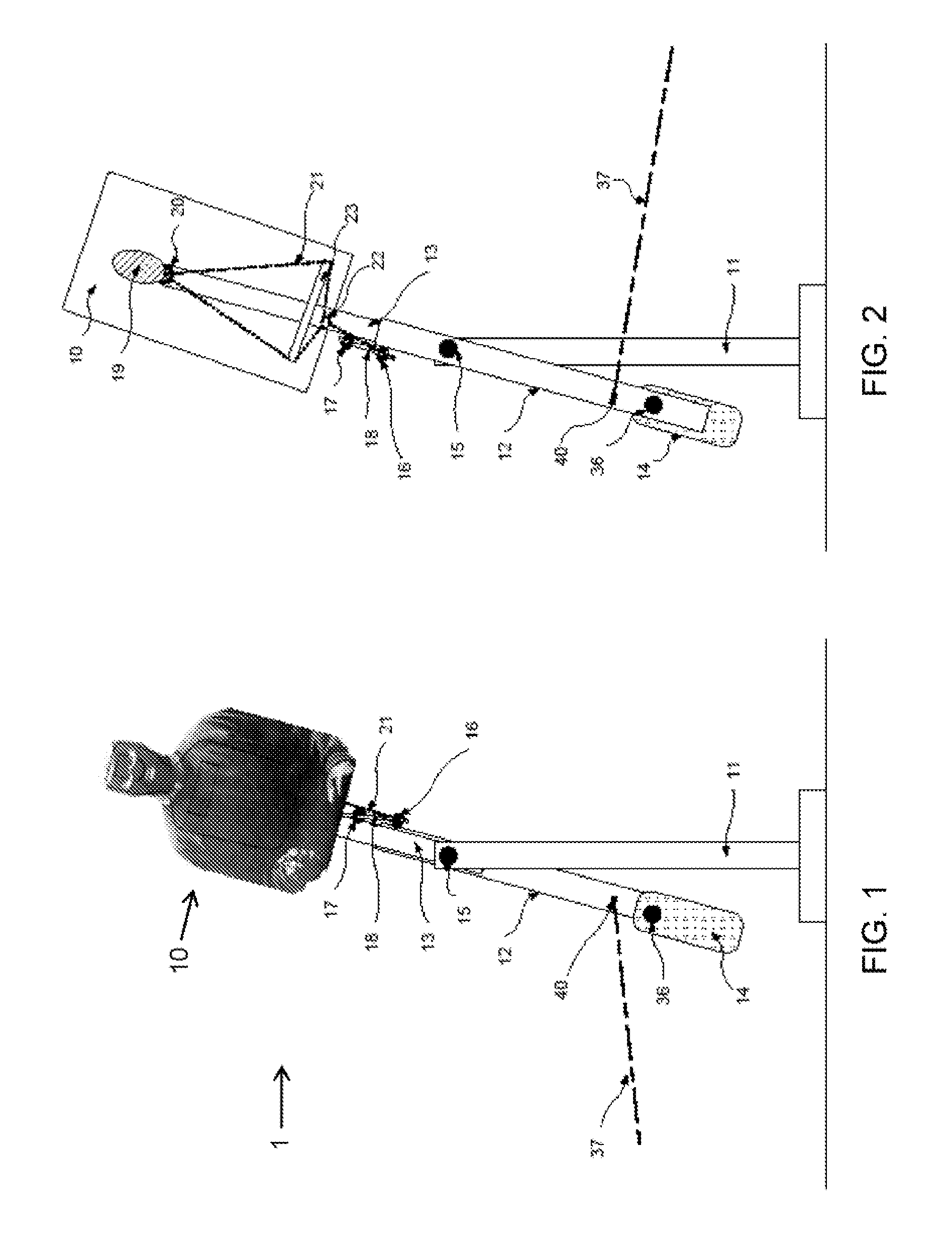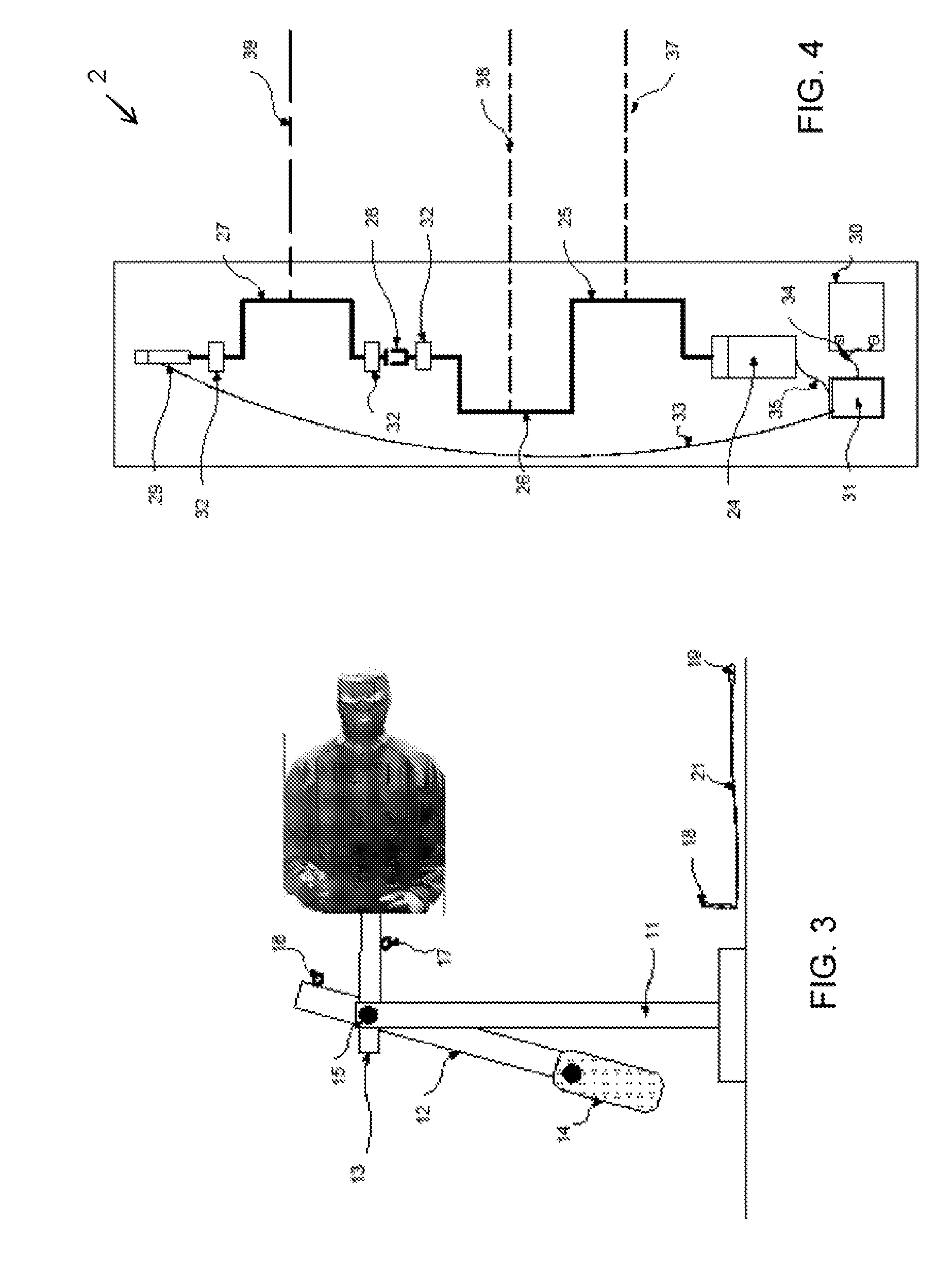[0011]The inventive target systems of the present invention provides a moving target system for marksmanship and target identification training that overcomes the hereinafore-mentioned disadvantages of the heretofore-known devices and methods of this general type and that improves the quality of shooter training, makes such training more consistent by giving the target movements that mimic that of a
human being—the movements are more random, non-synchronous, and / or non-repetitive. The movements of the inventive system are produced with a
motor drive that can accept any type of target, such as a bull's eye, a circle, and other defined objects. The targets most often used in training law
enforcement and military shooters depict a person. Thus, the system of the present invention can provide targets in the image of a person, whether presenting a weapon (a threat) or not presenting a weapon (no-threat or hostage).
[0024]The
crankshaft cranks are connected through a cord to targets having an adjustable counterweight, for example, at a bottom thereof. The target swings back and forth on a center axle but its movements are controlled by various measures. One control is effected with the speed of the motor driving the
crankshaft; higher
revolutions per minute translate into faster target arc movement rates. Another control is a position of the counterweight relative to the swing arm on which the target arm is mounted. If the counterweight is positioned directly in line with the target swing arm, the target movements will be more smooth and even. However, if the counterweight is positioned at progressively greater angles with respect to the swing arm, the target movements become more erratic and non-synchronous. Another factor influencing control is the duration of motor on time. If the
motor drive is on continuously, the target movements will be more smooth and rhythmic. However, if the
motor drive is turned on and off, whether periodically or randomly, the target will display erratic or
chaotic movements. A further factor influencing
target control is the length of a cord connecting the target swing arm to the
crankshaft crank. If the cord between the motor and the crankshaft
crank to which it is attached is shorter, the target will swing in a larger arc, following the movement of the crankshaft
crank to which it is attached.
[0026]The image of the person on a printed target can have a hand visible to the shooter. This hand can contain a weapon, defining the target a “threat” target. The system of the present invention allows the system operator to remotely and instantly change the target threat status from a “threat” to a “no-threat” or from a “no-threat” to a “threat.” The target system has a selectable crank, which the operator can engage using a
remote control. In use, the image of the weapon in the target's hand is covered by an obscuring medium (such as a piece of
cardboard with a section of newspaper glued to it to depict a person holding a newspaper). A mechanical connector holds the obscuring medium in place over the target image's band (holding the weapon). The mechanical connector can be a large staple, Velcro, double-sided tape, a paper clip, a piece of wood with nails in it, or any other
fastener that can be quickly removed with little force. The obscuring medium itself or the device being used to hold the obscuring medium to the target image is connected through a cord to the selectable crank on the crankshaft. When the operator energizes, for example, the push
solenoid actuator using a
remote control, the selectable crank is connected to the moving crankshaft with an engagement or
locking mechanism. The continuously turning crankshaft now can turn the selectable crank and pull the obscuring medium off the front of the target or pull the contrivance holding the obscuring medium on the target face free from the target. The obscuring medium falls to the ground (or elsewhere) and the target reverts from a “no-threat” to a “threat” with the weapon now visible.
[0027]The system also allows the operator to change the “threat” target to a “no-threat” target. For example, an image of a hand or other non-lethal object is connected firmly over the weapon image on the target and an obscuring medium containing the image of a weapon (or weapon in a hand) is placed over the hand. Thus, while the weapon is visible, the shooter must engage the threat target. However, as soon as the target changes to a no-threat target—when the obscuring medium is removed and simulating the target having dropped their weapon—the shooter must cease fire. This is excellent training for the shooter because it prevents a shooting of a no-threat target.
[0028]The invention has a number of distinct advantages over prior art target systems. First, the system is able to mimic human movements, increasing the level of shooter training. Next, these unique movements are adjusted easily by the system operator and permit a variation of different skill levels. Simple, slow movements can be used for new shooters and more difficult, random and erratic movements can be used for advanced shooters. Further, the system can quickly change the status of the target from threat to no-threat or vice-versa, changes that occur
in real life situations. This changeability requires the shooter to constantly be aware of the target's status, improving the skill set of the shooter. Additionally, the system is configured to require the shooter to accurately engage single or multiple moving targets. With an ability to present two targets at one time, one in front of the other, the shooter is given the opportunity to practice engaging a “threat” target while avoiding the no-threat target. The targets can be arranged with the no-threat target in front and the threat target behind or vice-versa. The system can even make both targets threat targets, requiring the shooter to engage both.
[0030]The system can be adjusted to present repeatable target movements to multiple shooters, thereby making it easier and more equitable when evaluating multiple shooters' capabilities. The system also can be operator adjusted to move the targets at controlled speeds and in predetermined and repeatable directions. Such features allow an instructor to work out a bad
habit of a student shooter, for example.
 Login to View More
Login to View More  Login to View More
Login to View More 


